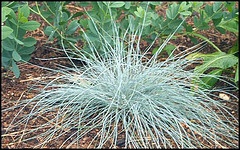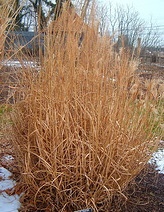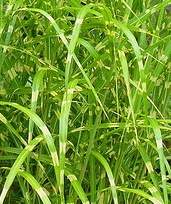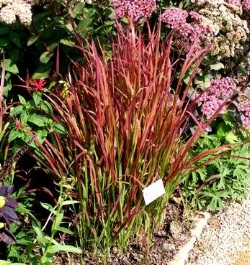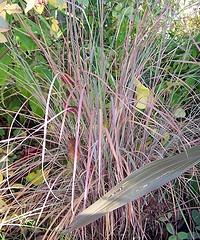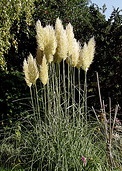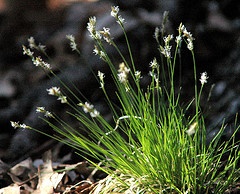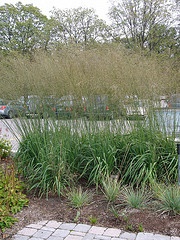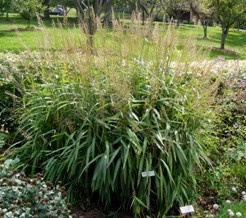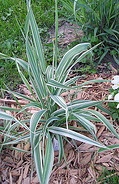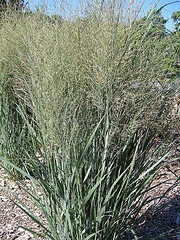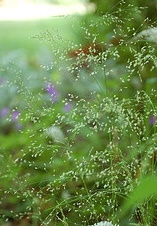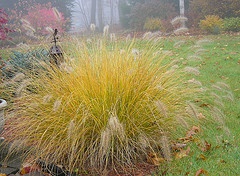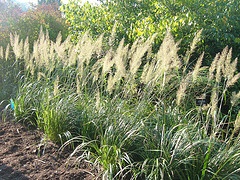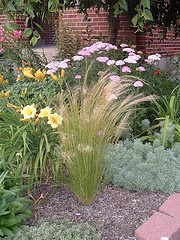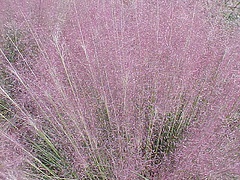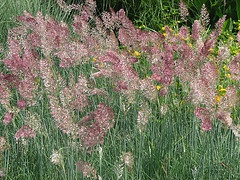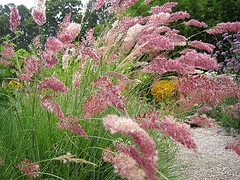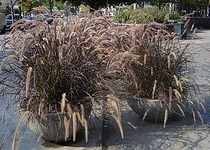17 Best Perennial Ornamental Grasses
As ornamental grasses gain more popularity new cultivars are introduced annually.
Choosing one that matches your soil and climate conditions, as well as your visual preference, should not pose a challenge.
However, given the recent weather extremes, it's advisable to consult your trusted garden center to identify the most suitable varieties for your area.
1. Blue Fescue (Festuca glauca)
This robust perennial grass has been a garden staple across the nation for some time.
It's a cool-season grass, evergreen in zone 5, hardy to zone 4, and some varieties can withstand zone 3. Its growth is low, reaching 6-10", and its mounding form is quite attractive.
Blue Fescue is an excellent option for containers, border edging, or mass planting. It thrives in sunny to partially shaded areas with dry, sandy soil, but it benefits from supplemental watering during dry spells. Heavy, wet soil is not suitable for this plant.
2. Blue Oat Grass (Helictotrichon sempervirens)
Oat Grass shares some similarities with Blue Fescue. It's a cool-season grass that grows in erect clumps and thrives in sunny to lightly shaded areas with average to dry soil.
In June, it produces one-sided seed heads that begin white and eventually turn golden.
This grass is evergreen in zone 5, hardy to zone 3 or 4, and can withstand altitudes up to 9,000 feet.
'Overdam'
3. Feather Reed Grass (Calamagrostis x acutiflora)
This robust perennial grass is considered a cool-season grass and can withstand zone 4.
However, in the cooler climates of the north, it transforms into a warm-season grass.
It features an upright and slender structure with arching fronds that can reach a height of 2 to 5 feet, depending on the variety.
The flower spikes of this grass typically last into the winter. Feather Reed Grass thrives in moderately moist conditions and can tolerate heavy soil.
'Avalanche'
The 'Karl Foerster' variety of Feather Reed Grass blooms earlier than most and is suitable for regions with a shorter growing season. It can reach a height of 4 to 5 feet and can withstand zone 3.
'Overdam' features white variegated foliage and performs best in lightly shaded areas. It grows up to 2 to 3 feet tall and can withstand zone 4.
'Avalanche' boasts variegated foliage, while 'Eldorado' has narrow green leaves with bright gold centers.
4. Fountaingrass (Pennisetum alpecuroides)
Gardeners have been using Fountaingrass for a while now. It's a warm-season grass that thrives in areas with full sun and moderately moist to moist soil.
Although it has been known to withstand zone 4, it's generally recommended for zone 5. In zone 4, it's advisable to provide winter protection in case of severe cold.
Fountaingrass can grow up to 3 or 4 feet in height, displaying bright green foliage and bottlebrush flowers. It's an excellent option as a specimen plant or in containers.
5. Hakone Grass (Hakonechloa macra ‘Aureola’ )
Hakone Grass is a robust and hardy warm-season perennial grass that thrives in shady areas and can withstand zone 4. Although there's some debate about its hardiness in this zone, this photo was taken from a zone 4 trial garden, and the grass looks healthy after a challenging winter.
This grass grows low, measuring 12-20 inches in height, and functions well as a ground cover or in containers. Its bright yellow foliage is slow-growing and performs best in light to heavy shade with moist acidic soil.
The 'Aureola' variety of Hakone Grass has a cascading form that adds movement to your garden, and its bright variegated leaves can brighten up darker corners of a shaded area.
6. Japanese Silvergrass (Miscanthus sinensis)
Maiden Grass Silvergrass
This hardy warm-season perennial grass variety can reach a height of 4-8 feet and can withstand zone 3. Its upright stature makes it ideal for screening specimen plants, large container plantings, or water features. It thrives in full sun and average to wet soils.
Silbefeder
Miscanthus is a diverse genus of grasses, and it's crucial to choose a reliably hardy variety. 'Silberfeder' produces wonderful plumes in the fall and can endure a zone 4 winter with ease. It features a vase-shaped structure with silver mid-rib foliage.
Strictus Porcupine Grass
'Strictus' can only withstand zone 5, although it may be marginally hardy in zone 4. It thrives in full sun to partial shade and is also known as porcupine grass due to its stiff leaves with yellow bands. This grass is visually striking and can brighten a dark corner or complement darker plants.
Some varieties of Silvergrass can be invasive, so it's best to grow them in cultivated and tended areas rather than near natural habitats such as prairies or woodlands, where they can spread uncontrollably.
7. Japanese Blood Grass (Imperata Japanese)
Red Baron Japanese Blood Grass
Blood Grass is a stunning ornamental grass with red-tipped blades that become increasingly red as it matures each season, ultimately turning blood red by autumn. To preserve its overall red color, any blades that revert to green should be removed.
This grass requires minimal maintenance and thrives in areas with sun to partial shade and moist, well-drained soil. It's best to apply granular fertilizer around the base of the plant every six weeks, but avoid allowing the granules to touch the foliage.
After the first freeze, it's advisable to remove the foliage. Some varieties of Blood Grass can spread aggressively, but 'Rubra' and 'Red Baron' are more controlled. You can divide them in the spring to propagate more plants and control their size.
Blood Grass is hardy in zones 5-9, but Imperata cylindrica 'Red Baron' can withstand zone 4. It grows up to 12-18" tall and can spread 24-35" wide. Its bright green blades have red tips, making it compact enough to use in small spaces or as an accent.
8. June Grass (Koeleria macrantha)
June Grass is a robust perennial that can withstand zone 3 and can tolerate some foot traffic. It's a small cool-season grass that grows up to 12-18" in height, making it ideal for tough areas. Its tight growth habit makes it a great option for borders and along paths in both sunny and shaded areas.
This grass produces showy white flower panicles in June, followed by straw-colored seed heads. It also serves as a host for butterfly larvae. June Grass thrives in areas with average to dry soil and can withstand altitudes up to 11,000 feet.
9. Lemon Grass (Cymbopogon citratus)
Lemon Grass is a stunning annual grass that gardeners grow not only for its accent qualities but also for its delightful citrus aroma and its use as a cooking herb. It features a bright mounded structure and can grow up to 2 feet in height.
To preserve the plant, it's best to grow Lemon Grass in pots and bring it indoors at the first sign of frost.
10. Little Blue Stem (Schizachyrium scoparium)
Little Blue Stem is a warm-season grass that thrives in dry conditions. It's a hardy perennial that can withstand zone 4, but it has also been found to be hardy in zone 3. Its clumps are either green or blue-green and are adorned with fluffy white seed plumes.
In the fall, the grass displays orange to red hues. Little Blue Stem prefers to grow in clay soil that is not overly wet and can tolerate light shade and drought. In 2011, the University of Minnesota introduced a new variety called 'Blue Heaven,' which is also hardy to zone 3. Its bluish foliage has burgundy tones, and its silvery-white seed heads provide stunning fall color.
11. Pampas Grass (Cortaderia selloana)
'Pumila' is a compact version of Pampas Grass, which is an annual warm-season grass.
This dwarf variety can grow up to about 3 feet in height. Unlike tender Pampas Grass, 'Pumila' is more cold-hardy and can be semi-perennial once established in zone 5, and it's hardy to zone 6.
Pampas Grass is often grown for its showy, fluffy white flower heads.
12. Pennsylvania Sedge (Carex pennsylvanica )
Sedge is a hardy, cool-season, low-growing perennial grass that serves as an excellent ground cover. It typically grows up to 6-12" in height and features a fine texture and a nicely mounded structure.
Sedge grass can thrive in both sunny and shaded areas with average to dry soil, and it's hardy to zone 3. There are also varieties that do well in more shade or very compacted soils, and new varieties are introduced every year, offering more diversity.
'Carex flacca,' also known as blue sedge, does well in some shade and is highly resilient.
13. Prairie Dropseed (Sporobolus heterolepis)
Prairie Dropseed is a hardy perennial grass that remains intriguing throughout the growing season. It features emerald green foliage with fine-textured seed heads and takes on a golden to orangish-red hue in the fall. This long-living native plant boasts a graceful arching form of thin, delicate leaves.
As a warm-season plant, Prairie Dropseed thrives in full sun and average to dry soils, and it's hardy to zone 3. Growing up to 2-3 feet in height, it's perfect for small spaces.
14. Purple Moorgrass (Molina caerulea)
Purple Moorgrass is a hardy perennial grass that features attractive clumps of light green upright arching flower stems. Its foliage turns yellow in the fall, and the brown, yellow, or purple flowers eventually fade to tan. This cool to warm-season grass is hardy to zone 3 or 4 and self-seeds.
Generally, Purple Moorgrass is mid-sized to tall, growing up to 5-7 feet in height. It prefers full sun and average to wet soil and does not thrive in high alkaline soil. However, mature leaves and flowers tend to break off at the base, reducing its winter interest.
'Skyracer' has tall spires of airy heads that work well to anchor tall structures or serve as a finishing point in a garden. 'Heidebraut' is more compact, reaching 4 feet in height, while 'Moorhexe' is also compact and features purple flowers.
15. Silver Spikegrass (Spodiopogon sibiricus)
Silver Spikegrass is a warm-season grass that thrives in a variety of soils and is hardy to zone 3. It features a shrub-like upright form with bold dark green foliage that turns yellow, orange, or red in the fall.
This grass serves well as screening or a hedge and is a long-term performer, growing up to 4 feet in height with fine flower heads that stand a foot above the foliage. It prefers full sun but can also thrive in light shade and average to moist soils.
16. Switchgrass (Panicum virgatum)
Switchgrass
This hardy perennial grass thrives in full sun and moderate to moist soil as a warm-season grass. Switchgrass grows to a height of 3 to 6 feet, featuring stiff upright clumps and showy, airy flowers of pink, red, or silver in midsummer. It can tolerate soil quality extremes, and its hardiness varies by variety from zones 3 to 4b.
Switchgrass is also known for attracting birds and self-seeding. It can be used for screening, water gardens, or prairie gardens. 'Heavy Metal' has been prone to rust, but 'Northwind' is an improved variety, featuring wide bluish foliage and an upright habit that can make an excellent focal point in a garden or landscape.
'Dewey Blue' is typically found in dry sandy coastal areas of the east and southeast, but it's highly resilient and does well in the midwest and even north, where it's hardy to zone 4. This grass grows to 4 feet in height, featuring a graceful habit and blue foliage. Its airy panicles of tan flowers appear in late summer, and the seed heads hang on through winter.
17. Tufted Hairgrass (Deschampsia caespitosa)
Tufted Hairgrass is a cool-season grass that prefers moderate to moist soil but doesn't thrive in clay. It's hardy to zone 3 but will require some supplemental watering.
This grass features dark green tufted foliage with airy flower panicles that change from green to yellow and nearly purple. It grows to 3 or 4 feet in height and can thrive in full sun or light shade.
'Northern Lights' is a variegated variety with cream, gold, and pink coloration that doesn't bloom. It's also hardy up to 12,000 feet in elevation.
Ideas for Using Ornamental Grasses in Your Garden
Many gardeners have yet to explore the beauty and versatility of ornamental grasses. Here are a few ideas for incorporating them into your garden, along with some additional varieties to consider:
Hemeln Fountain Grass Penniseturn alopecuroide
Calamagrotstis brachytrica Korean Feather Reed Grass
Mexican Feather Grass
Muhlenbergia capillaris Pink Muhly Grass
Pennisetum 'Phoenix Magenta' Grass
Pink paintbrush grass Melinis nerviglumis 'Savannah'
Huge Planters of Ornamental Grass
The possibilities for use are endless, have some fun with grass!
